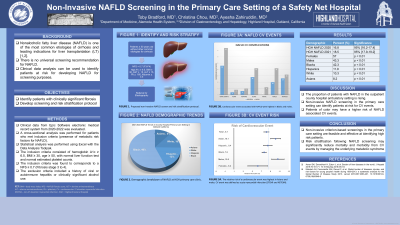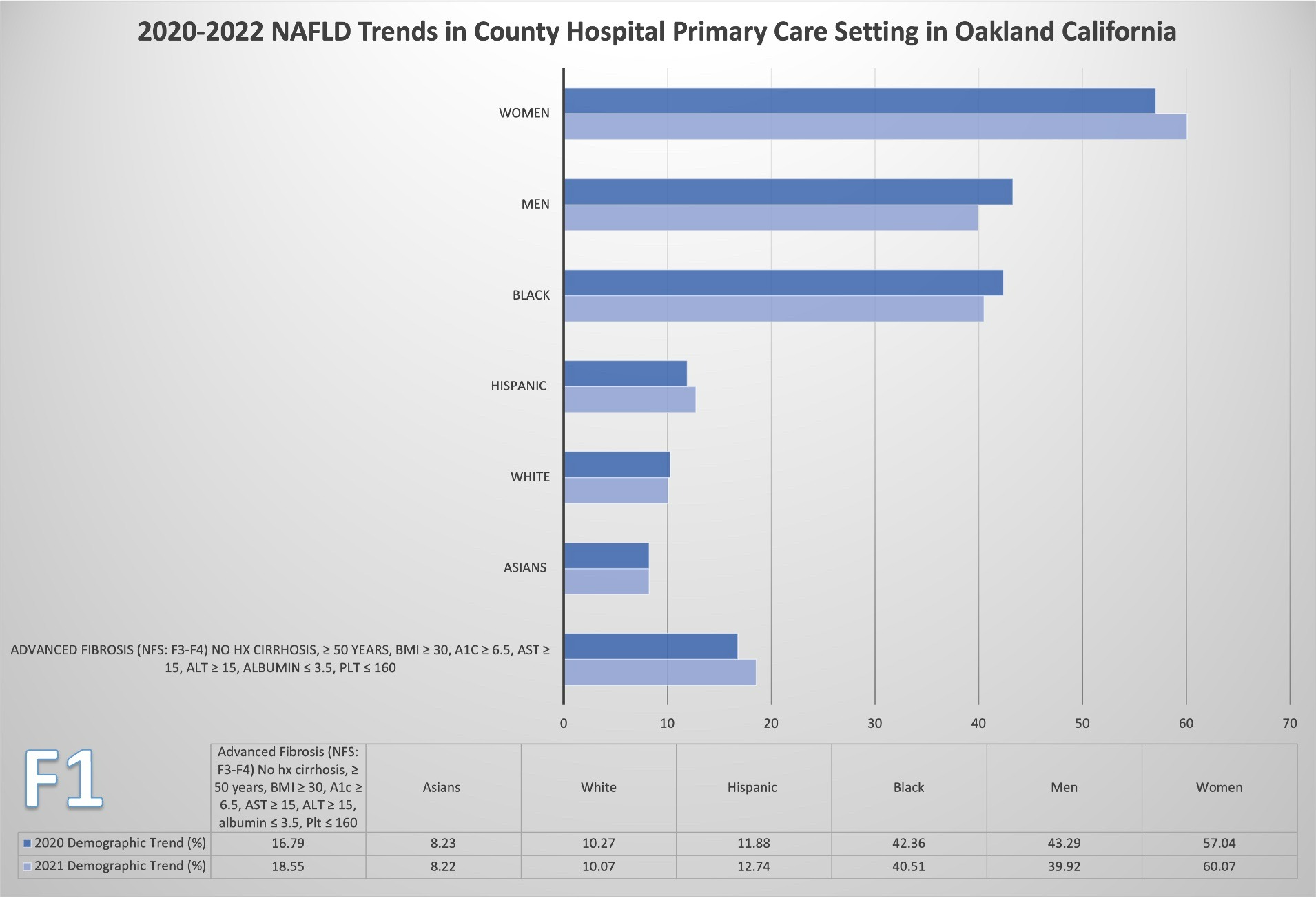Back


Poster Session A - Sunday Afternoon
Category: Liver
A0460 - Non-Invasive NAFLD Screening in the Primary Care Setting of a Safety Net Hospital System
Sunday, October 23, 2022
5:00 PM – 7:00 PM ET
Location: Crown Ballroom

Has Audio
.jpg)
Toby M. Bradford, MD
Alameda Health System
Oakland, CA
Presenting Author(s)
Toby M. Bradford, MD1, Christina Chou, MD2, Ayesha Zahiruddin, MD3
1Alameda Health System, Oakland, CA; 2Alameda Health System – Highland Hospital, Oakland, CA; 3Highland Hospital at Alameda Health System, Oakland, CA
Introduction: Nonalcoholic fatty liver disease (NAFLD) is one of the most common etiologies of cirrhosis and fastest growing indications for liver transplantation in Western countries. Currently, there is no universal recommendation for NAFLD screening in the primary care setting. Clinical data analysis can be used to identify patients at risk for developing NAFLD with advanced liver disease so that these patients can be referred for liver elastography for further risk stratification.
Methods: 2528 patients from the Highland primary care clinic in Oakland California from 2020 to 2022 were evaluated using the Epic Software electronic medical record system. The inclusion criteria included patients at Alameda Health System (AHS) Highland Hospital Adult Medicine with a hemoglobin A1c ≥ 6.5%, BMI ≥ 30, age ≥ 50, with aspartate aminotransferase (AST) ≥ 15 U/L, alanine transaminase (ALT) ≥ 15 U/L, albumin < 3.5 mg/dL, and platelets (PLT) < 160 per microliter that, at a minimum, corresponds to a NAFLD Fibrosis Score (NFS) of 0.7 (Fibrosis stage 3-4). The exclusion criteria included a history of viral or autoimmune hepatitis, clinically significant alcohol use, or previously diagnosed cirrhosis from an etiology other than NAFLD.
Results: The percentage of patients with NAFLD who were at risk for advanced liver disease increased from 16.79% [Confidence Interval (CI) 0.61; 16.2-17.4] in 2020-2021 to 18.55% [CI 0.57; 17.9-19.2] in 2021-2022. The percentage was highest in Black patients (42.3%, p < 0.01) and female patients (57.0%, p < 0.01), and lowest in Asian patients (8.2%, p < 0.01) (Figure 1). The percentage of Black, White, Asian, and male patients was relatively unchanged from 2020 to 2022, while the percentage in Hispanic patients increased from 11.9% to 12.7%, and the percentage of women increased from 57.0% to 60.1% (Figure 1).
Discussion: NAFLD with advanced liver disease is closely associated with diabetes and obesity. The United States Preventive Services Task Force currently does not recommend screening for NAFLD. However, non-invasive criterion-based screenings are feasible and effective at identifying patients with risk factors for developing NAFLD with advanced liver disease. Furthermore, screenings should be implemented in the primary care setting using criterion targeted clinical data, to identify patients who will benefit from liver elastography, so that early interventions can be performed to prevent cirrhosis and cardiovascular related complications.

Disclosures:
Toby M. Bradford, MD1, Christina Chou, MD2, Ayesha Zahiruddin, MD3. A0460 - Non-Invasive NAFLD Screening in the Primary Care Setting of a Safety Net Hospital System, ACG 2022 Annual Scientific Meeting Abstracts. Charlotte, NC: American College of Gastroenterology.
1Alameda Health System, Oakland, CA; 2Alameda Health System – Highland Hospital, Oakland, CA; 3Highland Hospital at Alameda Health System, Oakland, CA
Introduction: Nonalcoholic fatty liver disease (NAFLD) is one of the most common etiologies of cirrhosis and fastest growing indications for liver transplantation in Western countries. Currently, there is no universal recommendation for NAFLD screening in the primary care setting. Clinical data analysis can be used to identify patients at risk for developing NAFLD with advanced liver disease so that these patients can be referred for liver elastography for further risk stratification.
Methods: 2528 patients from the Highland primary care clinic in Oakland California from 2020 to 2022 were evaluated using the Epic Software electronic medical record system. The inclusion criteria included patients at Alameda Health System (AHS) Highland Hospital Adult Medicine with a hemoglobin A1c ≥ 6.5%, BMI ≥ 30, age ≥ 50, with aspartate aminotransferase (AST) ≥ 15 U/L, alanine transaminase (ALT) ≥ 15 U/L, albumin < 3.5 mg/dL, and platelets (PLT) < 160 per microliter that, at a minimum, corresponds to a NAFLD Fibrosis Score (NFS) of 0.7 (Fibrosis stage 3-4). The exclusion criteria included a history of viral or autoimmune hepatitis, clinically significant alcohol use, or previously diagnosed cirrhosis from an etiology other than NAFLD.
Results: The percentage of patients with NAFLD who were at risk for advanced liver disease increased from 16.79% [Confidence Interval (CI) 0.61; 16.2-17.4] in 2020-2021 to 18.55% [CI 0.57; 17.9-19.2] in 2021-2022. The percentage was highest in Black patients (42.3%, p < 0.01) and female patients (57.0%, p < 0.01), and lowest in Asian patients (8.2%, p < 0.01) (Figure 1). The percentage of Black, White, Asian, and male patients was relatively unchanged from 2020 to 2022, while the percentage in Hispanic patients increased from 11.9% to 12.7%, and the percentage of women increased from 57.0% to 60.1% (Figure 1).
Discussion: NAFLD with advanced liver disease is closely associated with diabetes and obesity. The United States Preventive Services Task Force currently does not recommend screening for NAFLD. However, non-invasive criterion-based screenings are feasible and effective at identifying patients with risk factors for developing NAFLD with advanced liver disease. Furthermore, screenings should be implemented in the primary care setting using criterion targeted clinical data, to identify patients who will benefit from liver elastography, so that early interventions can be performed to prevent cirrhosis and cardiovascular related complications.

Figure: Figure 1 (F1): Demographic trends for NAFLD in AHS county hospital primary care setting in Oakland California from 2020 to 2022.
Disclosures:
Toby Bradford indicated no relevant financial relationships.
Christina Chou indicated no relevant financial relationships.
Ayesha Zahiruddin indicated no relevant financial relationships.
Toby M. Bradford, MD1, Christina Chou, MD2, Ayesha Zahiruddin, MD3. A0460 - Non-Invasive NAFLD Screening in the Primary Care Setting of a Safety Net Hospital System, ACG 2022 Annual Scientific Meeting Abstracts. Charlotte, NC: American College of Gastroenterology.

